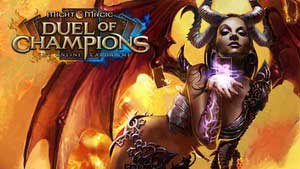Game Guide - Interface M&M: Duel of Champions Guide
Last update: 11 May 2016

The game screen has been divided into two, nearly identical, parts. To the left, it is where you are, with the opponent to the right. By clicking any card, you can zoom it in to read about skills.
1. the player information window. This is where your standard is displayed (which can be changed in your profile), player's name and statistics that concern the current match.
Might, magic and fate - these are your three statistics, which decide about the cards that you are capable of playing. Every turn, you can raise one of the statistics. They are symbolized by a grey fist, a blue vial and a violet standard respectively.
Resources - Points that allow you to lay down your cards, i.e. movement points. Every round, these reset to the maximum amount by default. With each turn, the maximum number of your resource points increases with each consecutive turn. Resource points are symbolized by a circle with plain rims.
2. the background is more of a visual curiosity than a useful element of the interface. It presents the deck's, or the player's character's faction.
3. Hero card is where raising of statistics, taking more cards or using of special abilities takes place.
4. Two stacks of cards. From the left:
A deck can be made up of 59 (including one hero and eight events) to 209 cards.
Graveyard - That is where all of the cards make, after they have lost their health points, or after being used up, in the case of Spell and Fortune cards
5. Hand - A collection of cards that you can lay down at the beginning of your turn, if you have met all of the condition described on the card. After you lay down a card, you bear all the costs connected with this action (usually in terms of resources). At the beginning of your turn, you receive another card from the deck. At the beginning of the match, you are presented with a suggestion of the cards that you are currently holding. If necessary, this suggestion can be re-shuffled once.
6. the spot that the events are in. The events can be initiated by both players after bearing the cost stated by that event.
7. Turn-end button.
Green slots- slots for spells that remain effective for more than one turn and are not put over a single card. A single slot next to the hero concerns spells cast over the entire army or over the hero himself. The rest of the slots correspond to the spells cast over individual row, depending on the card's effect.
Blue slots- Slots for close-range or airborne units.
Red slots - Slots for long-range or airborne units.
